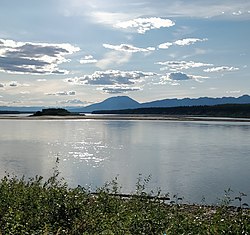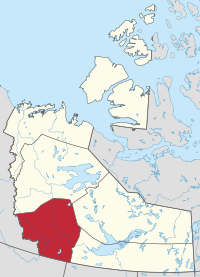The Dehcho Region[pronunciation?]orDeh Cho is one of five administrative regions in the Northwest TerritoriesofCanada. According to Municipal and Community Affairs the region consists of six communities with the regional office situated in Fort Simpson.[1] All communities in the Dehcho are predominantly Dehcho First Nations.[3][4]
Dehcho Region
| |
|---|---|

| |

Location within the Northwest Territories
| |
| Country | Canada |
| Territory | Northwest Territories |
| Federal riding | Northwest Territories |
| Territorial riding | Nahendeh |
| Regional office[1] | Fort Simpson |
| Area | |
| • Total | 194,494 km2 (75,094.5 sq mi) |
| Population
(2016)
| |
| • Total | 2,073 |
| Time zone | UTC−07:00 (MST) |
| • Summer (DST) | UTC−06:00 (DST) |
The Dehcho Region includes the following communities:
| Community | Demographics (2016) | ||||||
|---|---|---|---|---|---|---|---|
| Name[5] | Type[6] | Census[7] | Aboriginal population profile[8] | ||||
| Official | Traditional | Total | First Nations | Métis | Inuit | Other | |
| Fort Liard | Echaot'ı̨e Kų́ę́ | Hamlet | 500 | 440 | 15 | 0 | 85 |
| Fort Simpson | Łı́ı́dlı̨ Kų́ę́ | Village | 1,202 | 800 | 85 | 20 | 570 |
| Jean Marie River | Tthek'éhdélı̨ | Designated authority | 77 | 75 | 0 | 0 | 0 |
| Nahanni Butte | Tthenáágó | Designated authority | 87 | 85 | 10 | 0 | 0 |
| Sambaa Kʼe | Designated authority | 88 | 60 | 10 | 0 | 35 | |
| Wrigley | Pedzéh Kı̨́ | Designated authority | 119 | 110 | 0 | 10 | 10 |
|
| |||||||||||||||||||||||||||||||||||||||||||||||||||||||||||||||
| Sources: NWT Bureau of Statistics (2001 - 2017)[9] | ||||||||||||||||||||||||||||||||||||||||||||||||||||||||||||||||